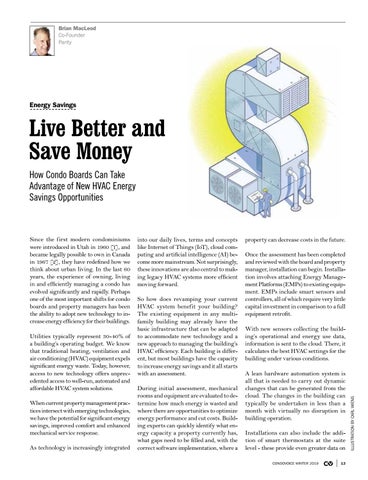Brian MacLeod Co-Founder Parity
Energy Savings
Live Better and Save Money How Condo Boards Can Take Advantage of New HVAC Energy Savings Opportunities
Utilities typically represent 30-40% of a building’s operating budget. We know that traditional heating, ventilation and air conditioning (HVAC) equipment expels significant energy waste. Today, however, access to new technology offers unprecedented access to well-run, automated and affordable HVAC system solutions. When current property management practices intersect with emerging technologies, we have the potential for significant energy savings, improved comfort and enhanced mechanical service response. As technology is increasingly integrated
into our daily lives, terms and concepts like Internet of Things (IoT), cloud computing and artificial intelligence (AI) become more mainstream. Not surprisingly, these innovations are also central to making legacy HVAC systems more efficient moving forward. So how does revamping your current HVAC system benefit your building? The existing equipment in any multifamily building may already have the basic infrastructure that can be adapted to accommodate new technology and a new approach to managing the building’s HVAC efficiency. Each building is different, but most buildings have the capacity to increase energy savings and it all starts with an assessment. During initial assessment, mechanical rooms and equipment are evaluated to determine how much energy is wasted and where there are opportunities to optimize energy performance and cut costs. Building experts can quickly identify what energy capacity a property currently has, what gaps need to be filled and, with the correct software implementation, where a
property can decrease costs in the future. Once the assessment has been completed and reviewed with the board and property manager, installation can begin. Installation involves attaching Energy Management Platforms (EMPs) to existing equipment. EMPs include smart sensors and controllers, all of which require very little capital investment in comparison to a full equipment retrofit. With new sensors collecting the building’s operational and energy use data, information is sent to the cloud. There, it calculates the best HVAC settings for the building under various conditions. A lean hardware automation system is all that is needed to carry out dynamic changes that can be generated from the cloud. The changes in the building can typically be undertaken in less than a month with virtually no disruption in building operation. Installations can also include the addition of smart thermostats at the suite level - these provide even greater data on CONDOVOICE WINTER 2019
CV
13
ILLUSTRATION BY CARL WIENS
Since the first modern condominiums were introduced in Utah in 1960 [1], and became legally possible to own in Canada in 1967 [2], they have redefined how we think about urban living. In the last 60 years, the experience of owning, living in and efficiently managing a condo has evolved significantly and rapidly. Perhaps one of the most important shifts for condo boards and property managers has been the ability to adopt new technology to increase energy efficiency for their buildings.
